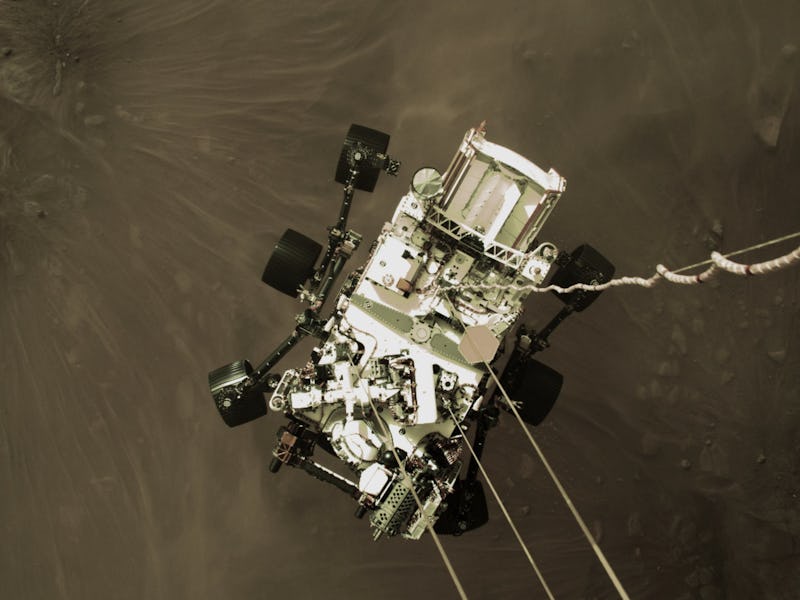NASA releases breathtaking video of Perseverance touching down on Mars
The rover survived the 7 minutes of terror — and has the video evidence to back it up.

On Monday, NASA unveiled the breathtaking footage of the Perseverance rover landing on Mars.
For the first time, cameras installed for the Mars 2020 mission were able to capture the tremendous feat of landing a rover on Mars in a thrilling video. The footage shows the deployment of Perseverance's parachute and as it lowered from the descent stage and safely touched down on the surface of Mars.
READ MORE PERSEVERANCE ROVER NEWS FROM INVERSE
Perseverance landed on Mars on February 18 at 3:55 p.m. Eastern time after traveling through space for nearly seven months. The rover touched down on Jezero Crater — a 28-mile wide, 1,600-foot deep crater located in a basin slightly north of the Martian equator.
Before it touched down on the dusty surface of the Red Planet, Perseverance underwent a series of intricate and terrifying maneuvers known as the 'seven minutes of terror.'
The video captures some of the thrilling moments of the SUV-sized rover approaching the alien world.
How did Perseverance land on Mars?
Perseverance entered the Martian atmosphere at 3:48 p.m. Eastern time. As it made its descent to the Red Planet, Perseverance went offline as ground control lost communication with the rover.
Due to an 11-minute delay in transmissions from Earth to Mars, Perseverance had to stick the landing on its own.
Before entering the atmosphere, Perseverance's entry capsule separated from the spacecraft that has been carrying the rover and its helicopter companion, Ingenuity.
As seen in the video, the spacecraft deployed a parachute about seven miles above the surface of Mars. The spacecraft soon separated from the parachute and was lowered onto the surface using a set of cables attached to an overhead floating descent stage.
Once Perseverance's wheels touched the surface of Mars, it cut the cables and safely landed on the planet.
This is our first look at exactly what it takes to land on another planet.
Here's where each parts of the descent ultimately landed on the way down to Mars.
How did NASA take video of the Perseverance landing?
Unlike rovers past, Perseverance was packed with an entry, descent and landing camera system that captured its smooth touchdown.
The final video is the result of a collaborative effort between four cameras. One camera was looking down on the rover from the spacecraft's descent stage, another camera was installed on the rover itself that was looking up at the descent stage, a camera on the top of the aeroshell encapsulating the rover that was looking up at that parachute, and a camera tucked on the bottom of the rover that looked down at the surface of Mars.
The camera system was not exactly crucial to the mission itself, but rather an exciting new addition. The camera system is 'off the shelf' equipment that was not designed to survive the freezing Martian temperatures. Therefore, the team does not expect the hardware to last for very long.
"The mission could still be 100% successful if our camera system didn't work," Dave Gruel, Perseverance EDL camera lead at NASA's Jet Propulsion Lab, said during a press briefing on Monday. "And if we could even get just one image or one piece of information back during EDL that we shouldn't get upset and we should be excited."
The first panoramic view from the Mars Perseverance rover took from Jezero Crater.
The Perseverance rover beamed back way more than just one image. Instead, the rover sent back 30 gigabytes of information and over 23,000 images of the vehicle descending down to the surface of Mars.
Perseverance is also the first NASA rover to carry a microphone to Mars, and was able to capture the soothing sounds of the Red Planet. A short snippet was played at Monday's press conference of wind on the surface of Mars.
What's next for the Perseverance rover
The rover is set to spend 687 days on Mars, the equivalent of one Martian year, hunting for clues of ancient microbial life.
Perseverance will collect samples of rock and dust from the Martian surface using its nine drill bits. But unlike previous missions to Mars, Perseverance will stow away those samples for a future sample return mission that will allow scientists to examine them in a lab on Earth.
The samples move through the belly of the robot, and into the Adaptive Caching Assembly System, where they are assessed and processed. The assembly system contains seven motors, and more than 3,000 parts including the Sample Handling Arm that the rover will use to hold sample tubes.
Perseverance will then leave the samples on Mars so that they can be picked up by another mission in the next few years.